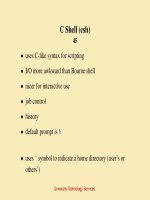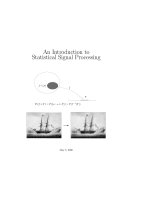Tài liệu An Introduction to PMI’s Project Management Life Cycle ppt
Bạn đang xem bản rút gọn của tài liệu. Xem và tải ngay bản đầy đủ của tài liệu tại đây (529.42 KB, 9 trang )
An Introduction to
PMI’s Project
Management Life
Cycle
1-800-COURSES
www.globalknowledge.com
Expert Reference Series of White Papers
The Project Management Life Cycle.
This paper provides a review of the steps and stages associated with project management according to the
Project Management Institute
®
(PMI). It is a primer for anyone new to the Project Management Body of
Knowledge
®
(PMBOK
®
) and who is preparing to take the PMP exam.
In order to understand how the Project Management Institute (PMI) recommends that projects be run it is nec-
essary to understand the project management life cycle. The project management life cycle is the framework
around which project management activities are structured. It is a key concept in formal project management
according to PMI.
In this paper the structure and function of the project management life cyle is introduced along with a num-
ber of related terms that are commonly confused.
What Is a Life Cycle?
The term ”life cycle” implies two things: that a process is perpetual and that the sequence of events is obliga-
tory or uni-directional.
A typical life cycle is depicted below
. There is no beginning or end to a life cycle and the sequence of events
cannot change. A seed cannot go directly to being a mature plant nor revert back to the blossom stage.
Brian Denis Egan, Global Knowledge Instructor, PMP
An Introduction to PMI’s Project
Management Life Cycle
Copyright ©2006 Global Knowledge T
raining LLC All rights reserved. PMI, PMP
, and PMBOK are registered
trademarks of the Project Management Institute, Inc.
Page 2
Seeds
Mature plant
Blossoms Seedling
The Project Management Life Cycle
The term “life cycle” is misleading, because it is neither a perpetual circle of events nor is the sequence of
events rigidly fixed.
There are five stages to the project management life cycle:
The five stages usually occur in sequence. If the project is relatively simple and there is no need to rethink or
re-plan the project, the sequence of stages may be as simple as that depicted above.
If there are problems with the original project plan, then the controlling function leads back to planning.
Execution may be delayed while additional planning takes place or may continue during re-planning. The new
or modified project plan is then executed.
During execution controlling processes are undertaken to ensure
that the correct work results are being achieved.
Below is a project management life cycle that has been forced by problems to return to planning.
During large complex projects it is often necessary to return to planning several times. In this case, the project
management life cycle can become very complex with multiple repeats of planning and even initiating
processes.
Below is an illustration of a complex project management life cycle involving multiple returns to the drawing
board.
Copyright ©2006 Global Knowledge T
raining LLC. All rights reserved.
Page 3
Project Life Cycle vs. Project Management Life Cycle
The ”project management life cycle” is different from the project life cycle. But the terms are often confused.
The project life cycle refers to the development phases that a project can go through. For example:
• Evaluate – Design – Build – Test – Launch
• Design – Code – Test – Train – Release
The phases that a project goes through are determined by the nature of the project. The project life cycle is
tailored to suit individual project needs.
In contrast, the project management life cycle stays the same for all projects.
Relationship of Project Management Life Cycle to Phases
of the Project Life Cycle
This is where things get really confusing.
Each phase of the project life cycle (such as Design or Code) can go through the entire project management
life cycle. In other words, each phase can be thought of as an independent project that has its own complete
project management life cycle
.
Stages of the project management life cycle, for the design phase of the project life cycle, are illustrated below.
The design phase is essentially an independent project that produces a deliverable. This deliverable becomes
an input to the coding phase, which in turn can go through the entire project management life cycle.
Each phase of a project does not necessarily go through the entire project management life cycle, but it can.
It is best to think of phases in the project life cycle as independent little projects
. What we originally thought of
as a “project” would best be referred to as a program consisting of several phases that are actually sub-projects.
Back to the Project Management Life Cycle
As explained, the project management life cycle has five stages (initiate, plan, execute, control and close). The
PMI refers to these stages as “process groups” for reasons that will be explained.
Copyright ©2006 Global Knowledge T
raining LLC. All rights reserved.
Page 4
I
n order to understand project management according to PMI, it is necessary to understand the boundaries
between the project-management-life-cycle stages or process groups. For example, it is necessary to know
when initiating is over and what documents must be ready in order to begin execution.
In order to understand the boundaries between the stages, it is necessary to know what management activi-
ties (called processes) are included within each of the stages (called process groups).
Project Management Life Cycle and Management Process
The five stages in the project management life cycle are subdivided by PMI into 44 management processes as
illustrated in the table below. Each column represents a stage. Within each column are a number of manage-
ment activities that PMI refers to as processes.
T
o know what management activities are included in each of the columns is to understand PMI’
s version of
project management.
Process Groups
PMI uses the term “process groups” to refer to stages in the project management life cycle, which appear as
the columns in the above illustration. Each column is therefore referred to as a ‘process group’. Each stage of
the project management life cycle is referred to as a process group rather than a stage or step in the life cycle
.
Copyright ©2006 Global Knowledge T
raining LLC. All rights reserved.
Page 5









